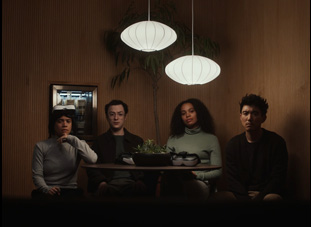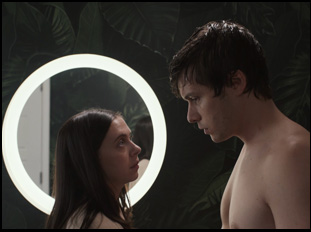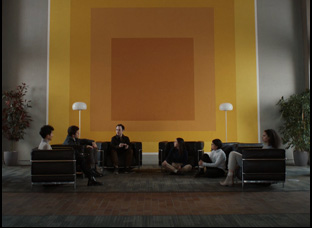When residents of the Our Friends Housing Community in the light sci-fi dramedy “Turn Me On” signed up for peace and tranquility, it’s unlikely they were imagining being quite as sedate as Joy (Bel Powley) and William (Nick Robinson) appear, worried about the mildest bump into one another in the morning as they go about their morning routine. The two share the same perfectly appointed and sterile apartment, but thanks to a pill they take each morning, they can’t really enjoy it or the time they spend in each other’s company when the point is to be deprived of their emotions that have gotten them into trouble in the past, cohabitating but barely engaged otherwise when their libidos have been suppressed and all other instincts have been dulled to make it through the day without incident.
It’s a dreary existence, but one that comes alive the second film from Michael Tyburski, who was able to previously suss out a fascinating world just lying under the surface of one we all already know in his arresting 2019 debut “The Sound of Silence.” Previously following a man played by Peter Sarsgaard who made it his business to set the mood in people’s houses and workspaces with exactly the right sonic balance, Tyburski again finds his main characters chasing a sense of peace, but working from a script by Angela Bourassa, the filmmaker asks at what cost as Joy is obliged to drop her regular medication for a period of time as she prepares for surgery and begins to feel things that she hasn’t in years. Her change in demeanor can’t help but intrigue others who left behind their lives to join Our Friends, a cult-like corporation that has lured in the disaffected – an orientation video that opens the film with its founder (Luke Kirby) extolling the virtues of a lifestyle trading passion for stability makes a convincing case to someone (Griffin Newman) who’s clearly reeling from recent heartbreak.
A renewed lust for life organically manifests itself into physical affection between Joy and William, who stops taking his pills as well, and before an administrator (D’Arcy Carden) can step in, a season of “syncing” as it’s come to be known sets in amongst the tenants at Our Friends, which can amuse when people awkwardly start to remember what being touched by someone else felt like physically but concern as well when it starts to remind of what they’ve been able to set aside emotionally. While that can exist as a fog to the characters, Tyburski is acutely tackles the wiliness of depression that led Joy and William to disengage in the first place, finding that dulling the pain by putting the world at a distance only leads to more for themselves, yet restoring curiosity becomes a way through, which the director does in spades as he is constantly hinting at a world where much wonder lies beyond what’s readily apparent and well worth seeking out. After Tyburski reenvisioned New York so evocatively in “The Sound of Silence” where he gave familiar locations a delightful air of mystery, the director again sees something new in what others might dismiss as mundane and believes in people’s capacity to surprise one another.
With the film recently finding its way onto VOD where it is ripe for discovery, Tyburski spoke about how he blended time periods and worked with a talented ensemble to make a spry drama both transcendent and grounded with its humanity.

After coming out of “The Sound of Silence,” which I loved writing and I loved making, but I have a tendency to be a little bit of a slow writer myself and as a director, I was definitely compelled to direct something again sooner than it takes time to develop. So this script came to me and when I read it, it was during those early days of the pandemic of 2020 and there were a lot of things in it that resonated with me thematically, but also somewhat ironically, I looked to it as some sort of escapism. In retrospect, I realized maybe I was projecting some of the things we were going through globally in this society [where] you actually can’t touch onto the script, and [I thought] “Well, how can I even make more of a dystopia around this?” The script felt like a good palette to create something fresh from.
With “Sound of Silence,” I was so impressed with the sense of place in it, a lot of which was exteriors and I realized halfway through this, I might be even more impressed with how you did it in this one, when you spend so much time indoors, but you have a really good idea of where you are. What was it like figuring out where you could set this?
It was definitely a challenge, but it is exciting. So much of directing and filmmaking is problem solving and that caters to creative solutions. Interestingly, when I read the original script that Angela Bourassa wrote, it was much more like a science fiction film with a capital S and a capital F. And I wanted to do something just visually that was less expected, but also we just didn’t have the budget for that sort of scope, so I tried to bring my own aesthetic into it by setting this somewhere rural and after having made a film in a city previously, it was interesting to create an entrepreneur city and a backstory for something that didn’t exist. We looked literally all over the world to find a place that was going to be economical to shoot it in, but I was looking for something specifically woodsy. When you’re building a fictional society from the ground up, there’s so many micro decisions that go into that. But we started with the idea that this fictional organization in the film maybe retrofitted an old college campus that was abandoned and we’re seeing it now several generations in, so there’s a little bit of the old world academic vibe in the architecture. Then there’s this slightly more modern boutique living space and [we would] mix those two, which also catered to my interest of having an unknown era and playing with retro analog tools that could exist in this world.
But so much of this film was interiors and I wanted that to play thematically into what these characters were going through of being very claustrophobic. Even though they’re living in this utopia, they’re stuck in a place, so we keep our camera very controlled that way, very observational and one thing that the art department came up with was to flood the interior space with a lot of lush greenery to bring the outdoors inside. There was also a bit of an allegorical Adam and Eve story within it all, so it felt right aesthetically.
One of the things that impressed me was how dynamic you could make the same location from one scene to another. For instance, in the bathroom that the main characters share, it’s a part of their routine, but the mirror, which never moves takes on a different quality when she begins to go off her medication and is sexually attracted to him. What was it like to look at the same spaces and figure out how to make those rooms come alive in a different way each time you see them?
It’s a lot of finding solutions within constraints, and that’s where interesting things come out. We weren’t doing a lot of original builds and we were working in very small spaces. We could augment the spaces that we found and we wanted the photography to have a bit of repetition in it [where] we’re seeing the same shots throughout the progression of the story, but they have new meanings, so we’re doing subtle things with the artwork and the color palette of the film starts off a bit cooler and gets a bit warmer as the characters’ emotions open up.
That bathroom set was one we knew we were going back in and it also played into this forbidden Adam and Eve side of [the story], so [in designing the wall] we were building a garden of Eden but with that sexual awakening that the characters are going through, I had no interest from the beginning of sensationalizing that more than it needed to be. As much as they’re physically [merging], it’s a movie about their emotional headspace and I think sometimes the less you see, the more that your imagination can build below the frame line, so working in that confined space and not really able to necessarily go to too wide of a shot, [we considered] how can we do this and stay honest to the character’s feelings.

I feel very grateful to have worked with such a good cast. It was an ensemble in so many ways for much of the shoot and the kind of rehearsal time that we did have, which was limited, we tried to incorporate a lot of play into that. Each of our main characters goes through being very subdued and suppressed to really experiencing emotions for the first time and we had very limited time to try things on the day, but we definitely had a lot of conversations leading up to what those two modes look like. I knew I didn’t want something prescriptive that they’re all following, and I love working with actors – I feel so spoiled to be able to witness each one of their processes – and they all interpret differently, so my job is to really hone it in and make sure it’s balanced so that it works in tandem within the ensemble. The universal direction that I gave all of them was just that there’s still souls behind all of the characters’ eyes, even though their emotions might be subdued, so they all interpreted that in their own unique way that I thought really worked.
Were there any directions this took that you might not have expected that you could get excited about as this started to take on a life of its own?
I’m the sort of director that shot lists everything very precisely, but at the same time, I never look at that shot list when we’re actually making the film. I do like to embrace spontaneity. And what I’ve learned from all the projects I worked on is being prepared allows space for things to happen organically. As much as you can prepare, you have that in your back pocket, but that’s really only in case of emergency. Even within the very limited constraints of time of a shoot like this to try things out, it’s finding a space to know what you’re doing and then letting see how each day and each moment evolves in a way that just feels honest. That’s what I’m always chasing, even though there’s a lot of very specific setups in this movie. It’s very controlled in the way we shot it, but it’s inherently necessary to be surprised in order to tell something that feels real.
How much did you actually want to make “Our Friends,” the organization, a presence in the movie?
It was really much more anonymous in the script phase. We had the D’Arcy Carden character [as a representative for the company], but from the beginning, I didn’t want to make this a movie about dissecting the evil organization or the powers that be. We’ve seen that a lot, so they are more of this metaphor and they give us opportunities for satire in terms of an organization that’s manipulating us subtly. And to get ahead of any problems that might come up with the narrative, I had designed something that wasn’t in the script, which ended up opening the film [with] the Luke Kirby character, who portrays the founder of this fictional society in an orientation video. We actually shot that during post-production and I knew I wanted to write that, so that we could fix any potential problems that might’ve come up in the story to fill in those holes and it was a bit of a tool, but it was something that I thought could help us.
It’s brilliant in another way too, which is that by virtue of being on a VHS tape, you start playing around with time. Subsequently, you’ve got these 1960-ish cartoons that keep the characters occupied. What was it like to create this liminal space?
I’m pulling certainly from a few places, but we did try to contain it. Probably the ’60s to ’80s were the eras we’re playing with with some of that tech and one of our main locations was actually once Kodak headquarters, which were kind of abandoned and locked in time in the middle part of those eras. So we [thought about] building this organization backwards from there, working in this place and [considering] what does that media look like? The latest iteration of that is VHS tape, which maybe comes from probably the late ’80s, early ’90s, but mixing in media [throughout] that fits, but also creates this anonymous era as well.
There’s different inspirations for each of those and reference points that we’re taking from to be inspired and then making our own bespoke version of that. That video that [the film] opens with was actually inspired by this company video that the Walt Disney Corporation made before Walt Disney’s death, where he was pitching Epcot Center as this kind of utopia and the language used in that is a bit of an homage. But I’m fascinated by those CEO types who are working a little bit out of their lane, doing something that started in one thing, but then they are now talking about creating their own universe and aware of their own world. I thought those were places that felt right aesthetically, but also historically to pull from.

I played a lot of music on set. It’s something I always like to do. And when I was in pre-production, I was thinking a lot about having vocalizations in the score. If these characters are being manipulated and observed, then [I thought] let’s have a Greek choir, as it were, observing them in a way. That evolved into what we use in the film – my composer Nate Heller ended up inserting his own voice and creating an interpretation of what I had in mind and we were using a lot of temp music at that point [based on] what I was playing on set, but then once you’re in the edit for six or eight months, you want to start fresh, or at least I did. It was so wonderful to hear his interpretations, which were more in line with the Beach Boys’ “Pet Sounds” album, with haunting, melodic voices. That paired with the images really well, helping to support the story in the way that I thought fit this world, which is a little unusual and unexpected. It also mixed in with a lot of the big orchestral pieces that I knew fit into the “Our Friends” world [where it felt like] their voice versus our unseen narrator of this Greek choir.
What’s it like to get to this point with the film and getting it out into the world?
It’s always exciting to finally finish something. And with audiences, that’s when films actually come to life again, so it always feels great. I’m grateful to get to keep making movies. I hope they let me do it again. But it’s also a little bittersweet because you get very attached to them. I think it’s healthy to be able to let go at a certain point – these children in a way that you’ve let out into the world, and you’ve done all you can to raise them. And now it’s really up to the audience to see how they are gonna perceive them. people might like them and people might not, but I tend to find that I’m interested in more the niche audiences seem to get attracted to the work that I’m putting out there. And that always feels great.
“Turn Me On” is now available to stream on Apple TV, Amazon and Fandango at Home.




